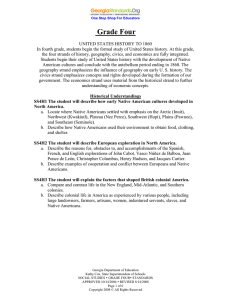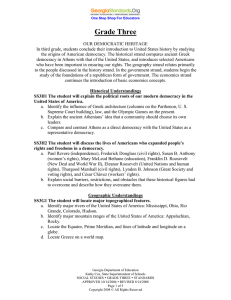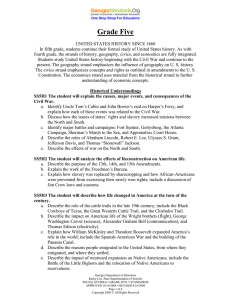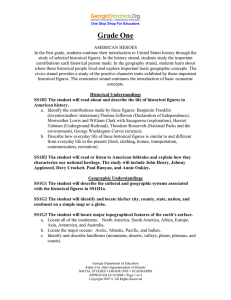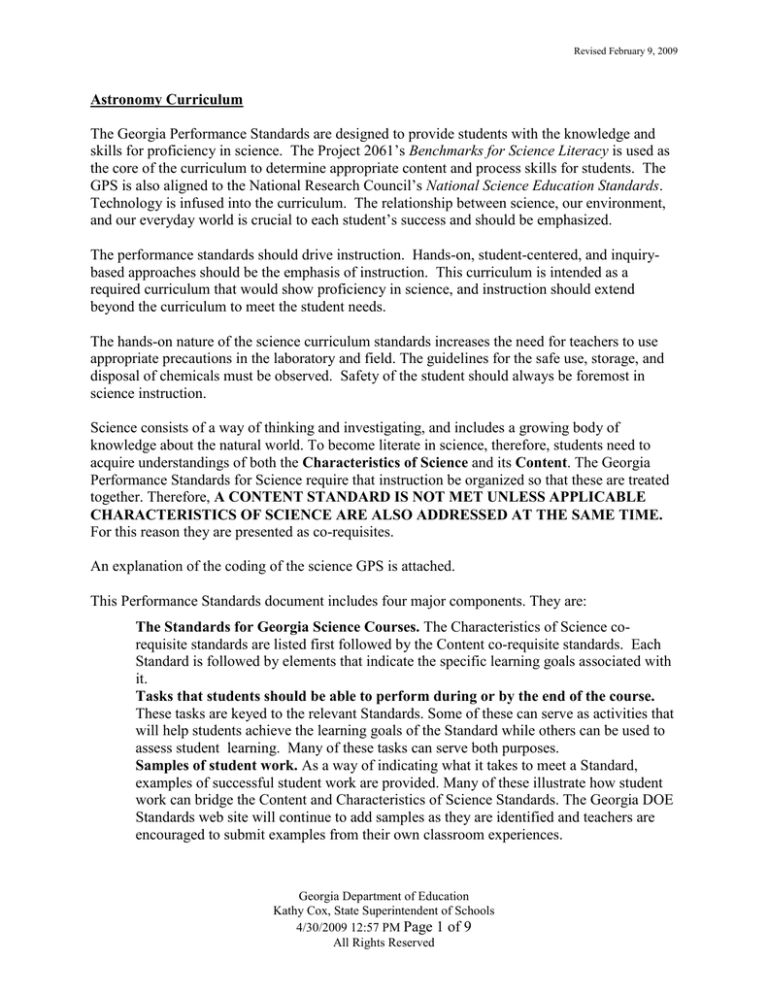
Revised February 9, 2009
Astronomy Curriculum
The Georgia Performance Standards are designed to provide students with the knowledge and
skills for proficiency in science. The Project 2061’s Benchmarks for Science Literacy is used as
the core of the curriculum to determine appropriate content and process skills for students. The
GPS is also aligned to the National Research Council’s National Science Education Standards.
Technology is infused into the curriculum. The relationship between science, our environment,
and our everyday world is crucial to each student’s success and should be emphasized.
The performance standards should drive instruction. Hands-on, student-centered, and inquirybased approaches should be the emphasis of instruction. This curriculum is intended as a
required curriculum that would show proficiency in science, and instruction should extend
beyond the curriculum to meet the student needs.
The hands-on nature of the science curriculum standards increases the need for teachers to use
appropriate precautions in the laboratory and field. The guidelines for the safe use, storage, and
disposal of chemicals must be observed. Safety of the student should always be foremost in
science instruction.
Science consists of a way of thinking and investigating, and includes a growing body of
knowledge about the natural world. To become literate in science, therefore, students need to
acquire understandings of both the Characteristics of Science and its Content. The Georgia
Performance Standards for Science require that instruction be organized so that these are treated
together. Therefore, A CONTENT STANDARD IS NOT MET UNLESS APPLICABLE
CHARACTERISTICS OF SCIENCE ARE ALSO ADDRESSED AT THE SAME TIME.
For this reason they are presented as co-requisites.
An explanation of the coding of the science GPS is attached.
This Performance Standards document includes four major components. They are:
The Standards for Georgia Science Courses. The Characteristics of Science corequisite standards are listed first followed by the Content co-requisite standards. Each
Standard is followed by elements that indicate the specific learning goals associated with
it.
Tasks that students should be able to perform during or by the end of the course.
These tasks are keyed to the relevant Standards. Some of these can serve as activities that
will help students achieve the learning goals of the Standard while others can be used to
assess student learning. Many of these tasks can serve both purposes.
Samples of student work. As a way of indicating what it takes to meet a Standard,
examples of successful student work are provided. Many of these illustrate how student
work can bridge the Content and Characteristics of Science Standards. The Georgia DOE
Standards web site will continue to add samples as they are identified and teachers are
encouraged to submit examples from their own classroom experiences.
Georgia Department of Education
Kathy Cox, State Superintendent of Schools
4/30/2009 12:57 PM Page 1 of 9
All Rights Reserved
Revised February 9, 2009
Teacher Commentary. Teacher commentary is meant to open the pathways of
communication between students and the classroom teacher. Showing students why they
did or did not meet a standard enables them to take ownership of their own learning.
Georgia Department of Education
Kathy Cox, State Superintendent of Schools
4/30/2009 12:57 PM Page 2 of 9
All Rights Reserved
Revised February 9, 2009
Georgia Performance Science Standards-- Explanation of Coding
Characteristics of Science Standards
SKCS1
Science Kindergarten Characteristics of Science Standard #1
S8CS2
Science Grade 8 Characteristics of Science Standard #2
SCSh8
Science Characteristics of Science high school Standard #8
Content Standards
S5P3
Science Grade 5 Physical Science Standard #3
S4E2
Science Grade 4 Earth Science Standard #2
S7L4
Science Grade 7 Life Science Standard #4
SC1
Science Chemistry Standard #1
SB4
Science Biology Standard #4
SPS6
Science Physical Science Standard #6
SP3
Science Physics Standard #3
SAST2
Science ASTronomy Standard #2
Georgia Department of Education
Kathy Cox, State Superintendent of Schools
4/30/2009 12:57 PM Page 3 of 9
All Rights Reserved
Revised February 9, 2009
Astronomy
This course will provide the student with an introduction to the concepts of modern astronomy,
the origin and history of the Universe and the formation of the Earth and the solar system.
Students will compare the Earth's properties with those of the other planets and explore how the
heavens have influenced human thought and action. The course gives a description of
astronomical phenomena using the laws of physics. The course treats many standard topics
including planets, stars, the Milky Way and other galaxies, black holes to more esoteric
questions concerning the origin of the universe and its evolution and fate. Although largely
descriptive, the course will occasionally require the use of sophomore-high level mathematics.
Laboratory exercises include experiments in light properties, measurement of radiation from
celestial sources, and observations at local observatories and/or planetariums.
Co-Requisite – Characteristics of Science
Habits of Mind
SCSh1. Students will evaluate the importance of curiosity, honesty, openness, and
skepticism in science.
a. Exhibit the above traits in their own scientific activities.
b. Recognize that different explanations often can be given for the same evidence.
c. Explain that further understanding of scientific problems relies on the design and
execution of new experiments which may reinforce or weaken opposing
explanations.
SCSh2. Students will use standard safety practices for all classroom laboratory and field
investigations.
a. Follow correct procedures for use of scientific apparatus.
b. Demonstrate appropriate technique in all laboratory situations.
c. Follow correct protocol for identifying and reporting safety problems and
violations.
SCSh3. Students will identify and investigate problems scientifically.
a. Suggest reasonable hypotheses for identified problems.
b. Develop procedures for solving scientific problems.
c. Collect, organize and record appropriate data.
d. Graphically compare and analyze data points and/or summary statistics.
e. Develop reasonable conclusions based on data collected.
f. Evaluate whether conclusions are reasonable by reviewing the process and
checking against other available information.
Georgia Department of Education
Kathy Cox, State Superintendent of Schools
4/30/2009 12:57 PM Page 4 of 9
All Rights Reserved
Revised February 9, 2009
SCSh4. Students use tools and instruments for observing, measuring, and manipulating
scientific equipment and materials.
a. Develop and use systematic procedures for recording and organizing information.
b. Use technology to produce tables and graphs.
c. Use technology to develop, test, and revise experimental or mathematical models.
SCSh5. Students will demonstrate the computation and estimation skills necessary for
analyzing data and developing reasonable scientific explanations.
a. Trace the source on any large disparity between estimated and calculated answers
to problems.
b. Consider possible effects of measurement errors on calculations.
c. Recognize the relationship between accuracy and precision.
d. Express appropriate numbers of significant figures for calculated data, using
scientific notation where appropriate.
e. Solve scientific problems by substituting quantitative values, using dimensional
analysis and/or simple algebraic formulas as appropriate.
SCSh6. Students will communicate scientific investigations and information clearly.
a. Write clear, coherent laboratory reports related to scientific investigations.
b. Write clear, coherent accounts of current scientific issues, including possible
alternative interpretations of the data.
c. Use data as evidence to support scientific arguments and claims in written or oral
presentations.
d. Participate in group discussions of scientific investigation and current scientific
issues.
The Nature of Science
SCSh7. Students analyze how scientific knowledge is developed.
Students recognize that:
a. The universe is a vast single system in which the basic principles are the same
everywhere.
b. Universal principles are discovered through observation and experimental
verification.
c. From time to time, major shifts occur in the scientific view of how the world
works. More often, however, the changes that take place in the body of scientific
knowledge are small modifications of prior knowledge. Major shifts in scientific
views typically occur after the observation of a new phenomenon or an insightful
interpretation of existing data by an individual or research group.
d. Hypotheses often cause scientists to develop new experiments that produce
additional data.
e. Testing, revising, and occasionally rejecting new and old theories never ends.
Georgia Department of Education
Kathy Cox, State Superintendent of Schools
4/30/2009 12:57 PM Page 5 of 9
All Rights Reserved
Revised February 9, 2009
SCSh8. Students will understand important features of the process of scientific inquiry.
Students will apply the following to inquiry learning practices:
a. Scientific investigators control the conditions of their experiments in order to
produce valuable data.
b. Scientific researchers are expected to critically assess the quality of data including
possible sources of bias in their investigations’ hypotheses, observations, data
analyses, and interpretations.
c. Scientists use practices such as peer review and publication to reinforce the
integrity of scientific activity and reporting.
d. The merit of a new theory is judged by how well scientific data are explained by
the new theory.
e. The ultimate goal of science is to develop an understanding of the natural
universe which is free of biases.
f. Science disciplines and traditions differ from one another in what is studied,
techniques used, and outcomes sought.
Georgia Department of Education
Kathy Cox, State Superintendent of Schools
4/30/2009 12:57 PM Page 6 of 9
All Rights Reserved
Revised February 9, 2009
Reading Standard Comment
After the elementary years, students are seriously engaged in reading for learning. This process
sweeps across all disciplinary domains, extending even to the area of personal learning. Students
encounter a variety of informational as well as fictional texts, and they experience text in all
genres and modes of discourse. In the study of various disciplines of learning (language arts,
mathematics, science, social studies), students must learn through reading the communities of
discourse of each of those disciplines. Each subject has its own specific vocabulary, and for
students to excel in all subjects, they must learn the specific vocabulary of those subject areas in
context.
Beginning with the middle grades years, students begin to self-select reading materials based on
personal interests established through classroom learning. Students become curious about
science, mathematics, history, and literature as they form contexts for those subjects related to
their personal and classroom experiences. As students explore academic areas through reading,
they develop favorite subjects and become confident in their verbal discourse about those
subjects.
Reading across curriculum content develops both academic and personal interests in students.
As students read, they develop both content and contextual vocabulary. They also build good
habits for reading, researching, and learning. The Reading Across the Curriculum standard
focuses on the academic and personal skills students acquire as they read in all areas of learning.
SCSh9. Students will enhance reading in all curriculum areas by:
a. Reading in all curriculum areas
Read a minimum of 25 grade-level appropriate books per year from a variety
of subject disciplines and participate in discussions related to curricular
learning in all areas.
Read both informational and fictional texts in a variety of genres and modes of
discourse.
Read technical texts related to various subject areas.
b. Discussing books
Discuss messages and themes from books in all subject areas.
Respond to a variety of texts in multiple modes of discourse.
Relate messages and themes from one subject area to messages and themes in
another area.
Evaluate the merit of texts in every subject discipline.
Examine author’s purpose in writing.
Recognize the features of disciplinary texts.
c. Building vocabulary knowledge
Demonstrate an understanding of contextual vocabulary in various subjects.
Use content vocabulary in writing and speaking.
Explore understanding of new words found in subject area texts.
d. Establishing context
Explore life experiences related to subject area content.
Georgia Department of Education
Kathy Cox, State Superintendent of Schools
4/30/2009 12:57 PM Page 7 of 9
All Rights Reserved
Revised February 9, 2009
Discuss in both writing and speaking how certain words are subject area
related.
Determine strategies for finding content and contextual meaning for unknown
words.
Co- Requisite -Content
SAST1.
Students will explain the tools used by astronomers to study electromagnetic
radiation to determine composition, motions, and other physical attributes of
astronomical objects.
a. Explain the challenges faced by astronomers due to the properties of light and the
vast distances in the cosmos.
b. Evaluate the types of telescopes used by astronomers for examining different
frequencies of electromagnetic radiation and compare and contrast the uses and
advantages of each (e.g. radio, visible, gamma ray, reflector, and refractor).
c. Mathematically apply Newtonian gravity to celestial bodies to determine their
masses and explain their motion (e.g. Kepler’s Laws)
d. Discuss how spectroscopy provides information about the inherent properties and
motions of objects.
e. Quantitatively analyze data from telescopes (e.g. spectra, multi-wavelength
photometry, and images) and/or other astronomical sources (e.g. tide tables, sky
charts).
SAST2.
Students will describe the scientific view of the origin of the universe, the
evolution of matter and the development of resulting celestial objects.
a. Outline the main arguments and evidence in support of the standard cosmological
model. (e.g. elements, solar systems, and universe)
b. Describe the life cycle of a star and explain the role gravity and mass play in the
brightness, life span, and end-stages of stars.
c. Compare and contrast the major properties of the components of our solar system.
SAST3.
Students will describe and explain the celestial sphere and astronomical
observations made from the point of reference of the Earth.
a. Evaluate the effects of the relative positions of the Earth, moon, and sun on
observable phenomena, e.g. phases of the moon, eclipses, seasons, and diurnal
cycles.
b. Describe how latitude and time of the year affect visibility of constellations.
c. Predict visibility of planets (major and minor) in the solar system based on
relative orbital motion.
Georgia Department of Education
Kathy Cox, State Superintendent of Schools
4/30/2009 12:57 PM Page 8 of 9
All Rights Reserved
Revised February 9, 2009
SAST4.
Students analyze the dynamic nature of astronomy by comparing and
contrasting evidence supporting current views of the universe with historical
views.
a. Evaluate the impact that technological advances, as an agent of change, have had
on our modern view of the solar system and universe.
b. Explain the relevance of experimental contributions of scientists to the
advancement of the field of astronomy.
SAST5:
Students will evaluate the significance of energy transfers and energy
transformations in understanding the universe.
a. Relate nuclear fusion reactions and mass-energy equivalence to the life cycle of
stars.
b. Explain the relationship between the energy produced by fusion in stars to the
luminosity.
c. Analyze the energy relationships between the mass, power output, and life span of
stars.
d. Describe energy transfers and transformations associated with the motion and
interactions of celestial bodies (e.g. orbits, binary pulsars, meteors, black holes,
and galaxy mergers).
SAST6:
Students will explore connections between cosmic phenomena and conditions
necessary for life.
a. Characterize the habitable zone in solar systems and habitable planetary bodies in
our own and other solar systems.
b. Describe the tools and techniques used to identify extrasolar planets and explore
extrasolar planetary atmospheres.
c. Describe signatures of life on other worlds and early Earth.
d. Explain how astronomical hazards and global atmospheric changes have impacted
the evolution of life on Earth.
Georgia Department of Education
Kathy Cox, State Superintendent of Schools
4/30/2009 12:57 PM Page 9 of 9
All Rights Reserved

